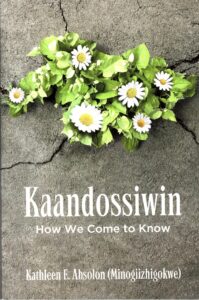Book review: Kaandossiwin: How We Come to Know
Kaandossiwin: How We Come to Know is an exploration of how, as an Anishinaabekwe, author Kathleen Absolon (Minogiizhigokwe) came to know, and by extension, an example of how Indigenous peoples come to know. To indicate the process of the journey, Absolon uses the term ‘re-search’ instead of ‘research’. This is done to indicate that Indigenous people are searching for knowledge that has been hidden, lost, or denigrated due to colonialism and neocolonialism. It is also indicative of Absolon reframing ‘research’ from an Indigenous perspective. Most importantly, Absolon’s journey serves as a pathway to learning about Indigenous methodologies.
Through the use of an image of a petal flower, Absolon demonstrates the components of seeking knowledge and its inter-relational components. There are six components to the flower and the seeking of knowledge discussed by Absolon. First is the roots, which represent the foundational elements, such as worldview. Second is the flower centre, which represents self in relation to the re-search, such as how Indigenous researchers situate themselves via “location, memory, motive and search for congruency.” Third is the leaves, which represent the journey, process, and transformation. Fourth is the stem, which represents the methodological backbone and supports. Fifth are the petals, which represent the diverse ways one can seek knowledge. Each petal represents a different way or method to re-search, indicating that there is more than one method or process in acquiring knowledge. It also shows that some petals are protected by those in front. Sixth is the environment in which the knowledge is formed and grows. The sixth aspect is key since flowers grow in multiple environments there are obviously multiple Indigenous methodologies in the search for knowledge. Absolon emphasizes this point since her work makes no claim to Indigenous universality in its discussion of how she came to know. Finally, all six parts of the flower are interconnected through various relationships that make it a flower. If there is a universalistic claim in her work, it is Absolon’s argument that Indigenous peoples share similar ideas about holistic research, relationship, and respect for community, and that they have a conscious knowledge that forefronts all that you do as a human being, researcher, and academic.
The Kaandossiwin journey that Absolon describes Indigenous methodologies and re-search without referencing or comparing it to Western methodologies. Absolon even answers the question of whether or not a non-Indigenous scholar can utilize Indigenous methodologies – in short, the answer is no. According to Absolon, aspects can be utilized by non-Indigenous researchers – respect, reciprocity, responsibility – but the non-Indigenous (unless raised in an Indigenous context) will lack the memory, world view, and other important cultural aspects that make Indigenous research methods Indigenous.
Kaandossiwin is an excellent theoretical model that Indigenous students, scholars, and others must read on their re-search journeys. Not to duplicate the work, but to be inspired and aided by it as they base their methodologies on where they come from, their culture, nation, and being. It presents a theoretically complex Indigenous methodology in an easy to read and follow format. It will also speak to common experiences in the Western Academy as we come to know.
Finally, it serves as building block for all Indigenous students following Absolon and other Indigenous scholars’ footsteps into academia.
Kathleen E. Absolon (Minogiizhigokwe), Kaandossiwin: How We Come to Know. Halifax: Fernwood Press, 2011.
ISBN: 9781552664407



